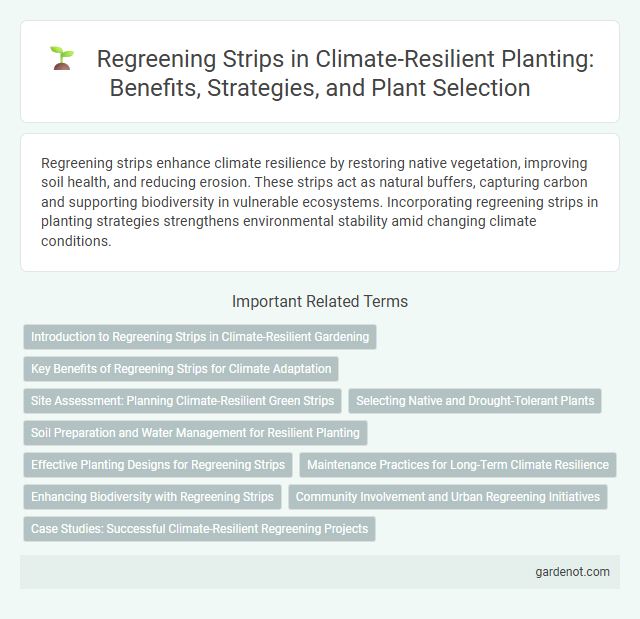Regreening strips enhance climate resilience by restoring native vegetation, improving soil health, and reducing erosion. These strips act as natural buffers, capturing carbon and supporting biodiversity in vulnerable ecosystems. Incorporating regreening strips in planting strategies strengthens environmental stability amid changing climate conditions.
Introduction to Regreening Strips in Climate-Resilient Gardening
Regreening strips are targeted planting areas designed to enhance soil fertility and increase biodiversity, playing a vital role in climate-resilient gardening by restoring degraded land. These strips typically incorporate native drought-tolerant species and nitrogen-fixing plants, which improve moisture retention and reduce erosion under changing climate conditions. Integrating regreening strips into agricultural and garden landscapes supports ecosystem services such as carbon sequestration and habitat creation, helping to mitigate the impacts of climate variability.
Key Benefits of Regreening Strips for Climate Adaptation
Regreening strips enhance soil moisture retention and prevent erosion, supporting sustainable agriculture under changing climate conditions. These vegetative buffers improve biodiversity by providing habitats for beneficial insects and wildlife, which helps maintain ecosystem balance. Their ability to sequester carbon contributes to climate change mitigation while increasing landscape resilience against extreme weather events.
Site Assessment: Planning Climate-Resilient Green Strips
Site assessment for climate-resilient regreening strips involves analyzing soil quality, topography, and local climate patterns to determine optimal planting zones. Evaluating water availability and erosion risks ensures the selection of species that enhance soil stability and biodiversity. Using geographic information systems (GIS) and remote sensing tools can improve precision in planning green strip layouts for maximum environmental impact.
Selecting Native and Drought-Tolerant Plants
Selecting native and drought-tolerant plants for regreening strips enhances soil stabilization and water retention, reducing erosion and improving resilience against climate stressors. Native species are adapted to local climate conditions, requiring less irrigation and maintenance while supporting biodiversity and ecosystem services. Incorporating drought-tolerant plants in regreening efforts maximizes survival rates during prolonged dry periods, promoting sustainable vegetation growth and carbon sequestration.
Soil Preparation and Water Management for Resilient Planting
Regreening strips enhance climate-resilient planting by improving soil structure through deep tilling and organic matter incorporation, which boosts water retention and nutrient availability. Strategic soil preparation reduces erosion and maximizes moisture infiltration, essential in arid and semi-arid regions. Efficient water management techniques, such as mulching and contour bunding, optimize water use and promote consistent soil moisture for sustainable plant growth.
Effective Planting Designs for Regreening Strips
Effective planting designs for regreening strips prioritize native, drought-tolerant species that enhance soil stability and biodiversity. Strategic layering of ground cover, shrubs, and trees maximizes water retention while creating microclimates conducive to growth in arid environments. Incorporating contour planting and mulching techniques further reduces erosion and conserves moisture, boosting overall climate resilience.
Maintenance Practices for Long-Term Climate Resilience
Regreening strip maintenance involves consistent weeding, mulching, and soil moisture monitoring to ensure healthy plant growth and soil fertility. Implementing periodic pruning and pest control enhances vegetation density and resistance to climate stressors. Long-term climate resilience depends on integrating adaptive management practices tailored to local environmental conditions.
Enhancing Biodiversity with Regreening Strips
Regreening strips significantly enhance biodiversity by creating habitat corridors that support diverse plant and animal species, improving ecosystem stability and resilience. These strips contribute to soil health by increasing organic matter and nutrient cycling, which fosters a thriving microhabitat for pollinators and beneficial insects. Integrating native vegetation within regreening strips further promotes ecological balance and mitigates the impacts of climate change on vulnerable ecosystems.
Community Involvement and Urban Regreening Initiatives
Regreening strips foster community involvement by engaging local residents in planting and maintaining vegetation corridors that enhance urban biodiversity and improve microclimates. These urban regreening initiatives transform underutilized spaces into green pockets, contributing to climate resilience through increased carbon sequestration and reduced heat island effects. Collaborative efforts between municipalities and community groups ensure sustainable management and social ownership, amplifying the ecological impact of regreening strips in cities.
Case Studies: Successful Climate-Resilient Regreening Projects
Case studies of successful climate-resilient regreening projects highlight the transformative impact of regreening strips in restoring degraded landscapes and improving soil fertility in semi-arid regions. In Niger, the Farmer Managed Natural Regeneration (FMNR) technique using regreening strips increased crop yields by 200% while enhancing carbon sequestration and biodiversity. These projects demonstrate that strategic planting of multipurpose trees and shrubs in strips contributes significantly to climate adaptation, food security, and ecosystem resilience.
Regreening strip Infographic

 gardenot.com
gardenot.com